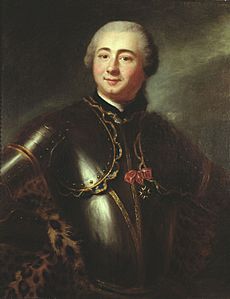Battle of Petitcodiac facts for kids
Quick facts for kids Battle of Petitcodiac |
|||||||
|---|---|---|---|---|---|---|---|
| Part of the French and Indian War | |||||||
|
|||||||
| Belligerents | |||||||
Mi'kmaq militia Acadian militia |
|||||||
| Commanders and leaders | |||||||
| Joseph Frye Captain Silvanus Cobb Joseph Gorham (wounded) |
Charles Deschamps de Boishebert | ||||||
| Strength | |||||||
| 200 | 300 | ||||||
| Casualties and losses | |||||||
| 22 killed, six wounded (disputed: French source indicates 42 killed, 45 prisoners) | 1 killed, 3 wounded | ||||||
The Battle of Petitcodiac was an important fight during the Bay of Fundy Campaign in 1755. It was part of the larger French and Indian War. The battle happened on September 4, 1755, in a village called Village-des-Blanchard. This village was located on the Petitcodiac River, near what is now Hillsborough, New Brunswick, Canada.
The battle was fought between British colonial troops and Acadian militiamen. These Acadian fighters were led by a French officer named Charles Deschamps de Boishébert.
Contents
Why the Battle Happened
After the British captured Fort Beauséjour in June 1755, they started to remove the local French-speaking people, called Acadians. This event is known as the Expulsion of the Acadians.
The British used Fort Cumberland (which was Fort Beauséjour) as their main base. From there, British soldiers and colonial militia went into the countryside. Their goal was to gather Acadians and destroy their homes and villages. Some Acadians gave up, but many others ran away from the coastal areas. They went deeper into the land.
These Acadians joined forces with local Mi'kmaq and Maliseet Native American groups. Together, they resisted the British efforts to force them out of their homes.
A French Leader Emerges

Charles Deschamps de Boishébert was a French military leader. He became a key figure in the resistance against the British. He was based in the Miramichi River valley. From there, he helped Acadians who were fleeing the British. He helped them escape to Quebec, a French territory.
After Fort Beauséjour fell, the British sent ships to remove Boishébert from a small fort he had at the mouth of the Saint John River. Boishébert knew he couldn't defend his position. So, he destroyed the fort himself.
When he heard that the British were planning to go to the Petitcodiac River, he quickly went to Chipoudy. There, he gathered 120 Acadians, Maliseets, and Mi'kmaq fighters. They formed a small, fast-moving fighting group.
British Plans for the Petitcodiac River
During the Bay of Fundy campaign, on August 28, 1755, the British sent Major Joseph Frye on a mission. He led 200 colonial militia from Fort Cumberland. They traveled in two armed ships. Their orders were to clear out Acadian settlements along the Petitcodiac River.
First, they set buildings on fire in Shepody, New Brunswick. Then, they moved up the river. As they went, they continued to burn settlements and take prisoners.
The Battle Begins
On September 2, the British expedition began clearing operations in and around Village-des-Blanchard. The main group of British soldiers worked on the eastern side of the river. A smaller group of about fifty or sixty men, led by John Indicot, went to the western side.
When Indicot's group set fire to the village church, Boishébert and his three hundred men attacked. The British soldiers quickly retreated behind a protective wall of earth, called a dyke. They were almost in a panic.
Major Frye then arrived with the rest of his forces and took command. The fighting was intense and lasted for three hours. Eventually, Frye managed to get his forces back to their boats and retreat. Twenty-two British soldiers were killed, and six more were wounded. A ranger named Joseph Gorham was among those wounded.
After the Battle
The Battle of Petitcodiac was a tough loss for the British. One writer, Abbe Le Guerne, said it "made the English tremble more than all the cannons of Beausejour." For many of the colonial fighters, this was their first time in a real battle. More than half of them were either killed or wounded.
For the Acadians, this battle was their first good news in a while. Boishébert managed to save thirty Acadian families. He also rescued valuable crops and supplies. Charles Deschamps de Boishébert et de Raffetot created a safe place for Acadian refugees. It was called "Camp de l'Espérance" (Camp of Hope). This camp was on Beaubears Island, near what is now Miramichi, New Brunswick.
Acadians also found safety in camps at Baie des Chaleurs and along the Restigouche River. On the Restigouche River, Boishébert's refugee camp was at Petit-Rochelle, which is now Pointe-à-la-Croix, Quebec. Boishébert continued to lead Acadians. He even led them against the British in the 1759 siege of Quebec.
The British would return three years later, in 1758. They destroyed the village again for the last time during the Petitcodiac River campaign.
Today, the site of the battle is marked by a special plaque. It was placed there by the Historic Sites and Monuments Board. This battle is recognized as one of the earliest National Historic Events in Canada. It was given this special status on May 16, 1918.

